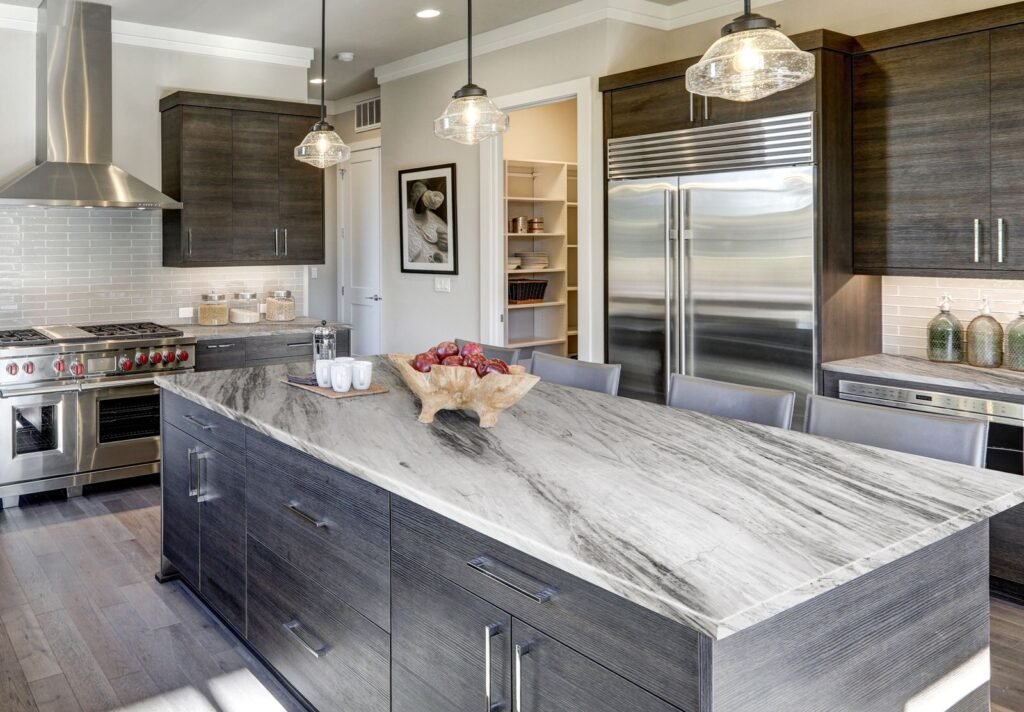Granite headstones are chosen for their beauty, strength, and permanence. Even so, damp shade, falling leaves, and airborne spores can leave mold, algae, and lichen on the surface. The good news: with stone-safe products and a gentle process, you can remove biological growth without scratching, bleaching, or dulling the granite stone. This step-by-step guide follows cemetery-conservation best practices and folds in smart maintenance so you don’t have to keep battling the same stains every season.

Key Takeaways
- Pre-wet, use a non-ionic stone cleaner, agitate gently, and rinse generously.
- Avoid bleach, vinegar, abrasive pads, and pressure washers. They can etch polish, leave salt residues, and accelerate future staining.
- Don’t seal outdoor monuments. Sealer can trap moisture beneath the surface; headstones must “breathe.”
- Annual light cleaning + better airflow (trimmed shrubs, less overhang) keeps new growth from returning quickly.

Why Mold Appears on Granite Headstones
Granite is a durable, intrusive igneous rock made primarily of quartz and feldspar with mica and accessory minerals. While denser and less porous than marble, it isn’t completely non-absorbent. Outdoor conditions—shade + moisture + nutrients (pollen, sap, dust)—let:
- Mold (black/sooty patches) colonize moist film on the polish
- Algae (green sheen) spread where water lingers
- Lichen (flat, paint-like patches) anchor to micro-texture on the surface
Understanding the biology helps you pick the least aggressive—and most effective—method to remove it.
Tools & Materials (Stone-Safe)
Cleaning gear
- 2 buckets (wash/rinse), low-pressure garden sprayer or watering can
- Soft nylon bristle brushes (hand brush + soft toothbrush for lettering)
- Microfiber cloths (for gentle wipe-downs and drying)
- Plastic scraper (old gift card) to lift softened lichen—never metal blades
- Plenty of clean water (5–10 gallons if there’s no nearby spigot)
Chemistry
- Non-ionic, pH-neutral stone cleaner (labeled for natural stone/masonry & biological soiling)
- Optional, as needed: stone-safe rust remover (for metal runoff) and poultice powder for stubborn organic stains
Safety & site care
- Nitrile gloves and eye protection
- Soft tarp to protect landscaping and capture residue
Heavy objects warning: If a headstone is leaning, broken, or needs moving, leave lifting to professionals with certified rigging and frames (e.g., Toolrange solutions or the Aardwolf Forklift Boom FB1-2720). This guide covers cleaning only.
What NOT to Use on Granite
- Bleach or chlorine tablets: leave salts that crystalize, can discolor inscription paint, and cause long-term damage.
- Vinegar, acids, or bathroom descalers: risk etching and mineral reaction.
- Abrasive pads, steel wool, scouring powders, “magic” erasers: microscratch polish so grime sticks faster later.
- Pressure washers: can pit the polish and drive water into joints.
- Topical waxes/sealers afterward: trap moisture on exterior monuments.
Step-by-Step: How to Clean Mold Off a Granite Headstone
1) Inspect & Pre-Wet
- Photograph the monument (overall + closeups). Note chips, cracks, or open joints.
- Wet the entire face thoroughly from top to bottom with clean water. Pre-wetting fills near-surface pores, so cleaner works on growth instead of soaking in.
2) Apply Non-Ionic Cleaner (Diluted)
- Mix per label (often 1:5 to 1:10 with water).
- Working bottom-to-top (reduces streaking), mist or sponge on a uniform film.
- Dwell 5–10 minutes, keeping it wet. Don’t let cleaner dry on the stone.
3) Gently Agitate
- With a soft nylon brush, scrub in small circles—light pressure is enough.
- Use a soft toothbrush inside letter grooves and carvings.
- For lichen, don’t pry it off dry. Let the cleaner soften its hold; if it lifts easily, a plastic scraper can assist.
4) Rinse Generously
- Rinse top-down with lots of clean water to carry away residues.
- If dark “ghosting” remains, repeat Steps 2–4 rather than scrubbing harder.
5) Spot-Treat Stubborn Stains
- Organic shadowing: Reapply cleaner; extend dwell to 10–15 minutes; agitate lightly; rinse.
- Rust/orange streaks (from pins/vases): Apply stone-safe rust remover per label; rinse thoroughly.
- Deep organic stains: Mix a poultice (commercial powder or baking soda + a few drops of water to peanut-butter thickness). Spread ⅛″ thick, cover with plastic for 24 hours, remove, and rinse.
6) Final Rinse & Dry
- Give the stone a final, generous rinse and hand-dry with microfiber to prevent mineral spotting—especially noticeable on dark granites.
7) Clean the Base & Surroundings
- Rinse base and nearby surfaces so runoff doesn’t redeposit grime. Bag and remove biological debris.
Dealing with Different Finishes & Colors
- Polished granite (most headstones): shows film and water spots more readily; always final-rinse and microfiber dry.
- Honed/flamed finishes: slightly more texture; stick with soft brushes to avoid snagging painted inscriptions.
- Black and very dark granites: highlight soap film and calcium spots; extra rinsing and drying help.
- Light granites: may reveal organic staining sooner; plan more frequent light cleans rather than an aggressive annual scrub.
Maintenance: Keep Mold from Coming Back Fast
- Annual light clean suits most climates; semi-annual in deep shade.
- Improve airflow and sun where allowed—trim shrubs, reduce overhang.
- Rinse after heavy pollen seasons so nutrients don’t stick to the surface.
- Skip sealers outdoors; they can trap moisture and haze.
- Keep fertilizers and soil mulch away from the base to reduce nutrient splash.
Granite Headstones vs. Indoor Granite Care
Outdoor monuments face UV, rain, and freeze–thaw cycles—very different from kitchens and baths where people clean granite countertops, worry about cooking oils, and sometimes discuss sealing granite, polishing granite surfaces, or removing stains from granite like wine or coffee. Products that are fine indoors (or for granite composite sinks) may not be appropriate outside. If you’re comparing, see How to Clean a Granite Composite Sink (different material class) and Can Granite Countertops Take Heat? to understand house-interior differences.
FAQs
Can I use household bleach to “kill” mold faster?
Avoid it. Bleach leaves salt residues that can promote future spalling and may lighten inscription paints. A non-ionic, pH-neutral cleaner plus patience is safer and just as effective.
What about vinegar or other acids?
Skip acids on polished granite. They can react with iron-bearing minerals and create dull spots or cloudy film.
Is a pressure washer on the lowest setting okay?
No. Even low-pressure tips can pit a polish and force water into micro-fissures and joints.
Should I seal the monument after cleaning?
Not outside. Monuments need to breathe; topical sealer can trap moisture and cloud over time.
How often should I clean?
Once a year for most sites; more often in shaded, humid microclimates. Think gentle and regular instead of aggressive and infrequent.
The headstone is leaning or cracked—what now?
Don’t move or reset it yourself. Call monument professionals who use proper stone transportation and lifting gear (see Toolrange and the Aardwolf Forklift Boom FB1-2720).
Troubleshooting Common Problems
Persistent lichen “shadows”
Repeat the non-ionic cleaning cycle a few weeks later. Lichens anchor with tiny hyphae; overly aggressive removal risks scratching. Time + gentle chemistry wins.
Orange/brown streaks
Often iron/rust runoff from metal flower holders or pins. Use a stone-safe rust remover, then rinse thoroughly.
White haze after drying
Usually soap film or hard-water deposits. Re-rinse with distilled water and dry with microfiber. Avoid over-concentrated cleaner.
Greasy or tarry spots
Use a poultice to draw out oily residues rather than scrubbing.
Quick 7-Step Checklist (Print This)
- Photograph, inspect, and pre-wet the stone thoroughly.
- Apply diluted non-ionic stone cleaner from bottom to top.
- Dwell 5–10 min, keeping surfaces wet.
- Gently brush with soft nylon; never use abrasives.
- Rinse top-down with plenty of clean water.
- Spot-treat with stone-safe rust remover or a poultice if needed.
- Final rinse & microfiber dry.
Related Topics & Helpful Resources
- Professional lifting/rigging inspiration: Toolrange
- Pro-grade boom for safe monument handling: Aardwolf Forklift Boom FB1-2720
- Indoor care comparison: How to Clean a Granite Composite Sink
- Kitchen heat myth-busting: Can Granite Countertops Take Heat?

